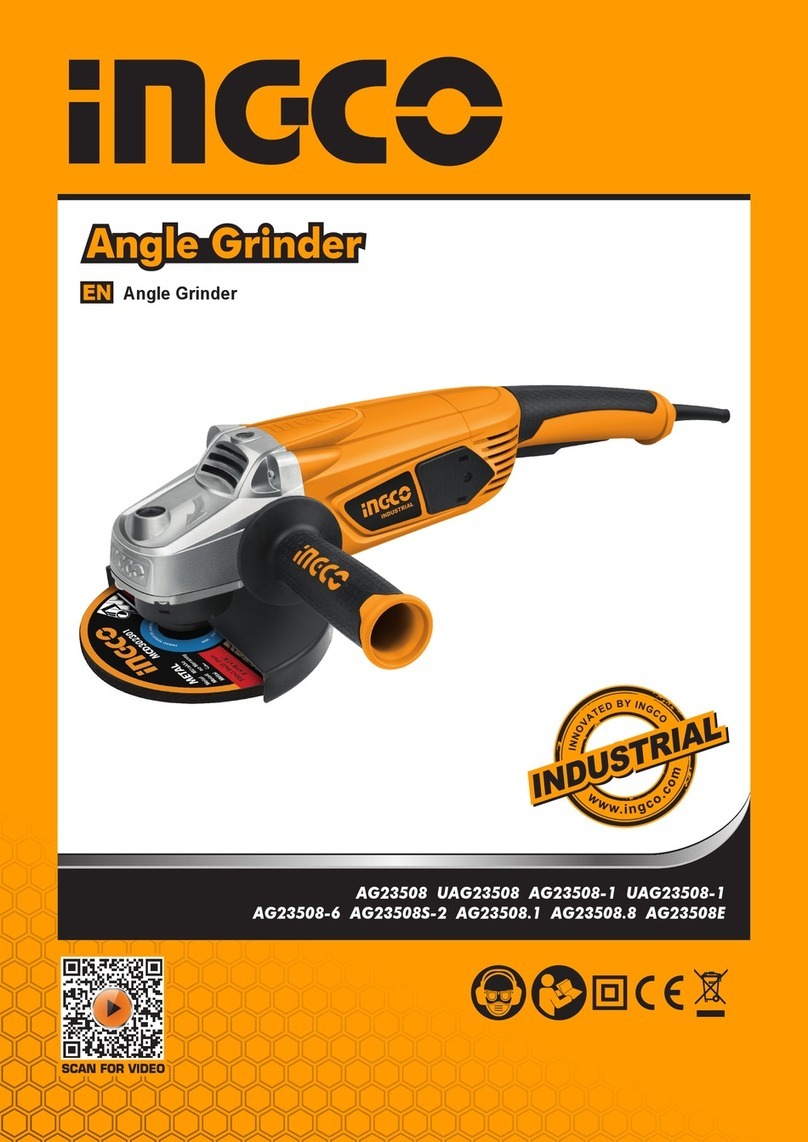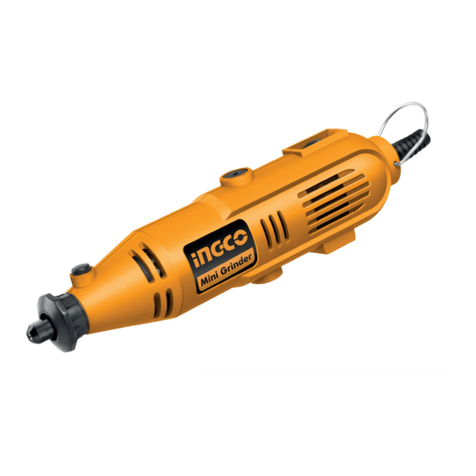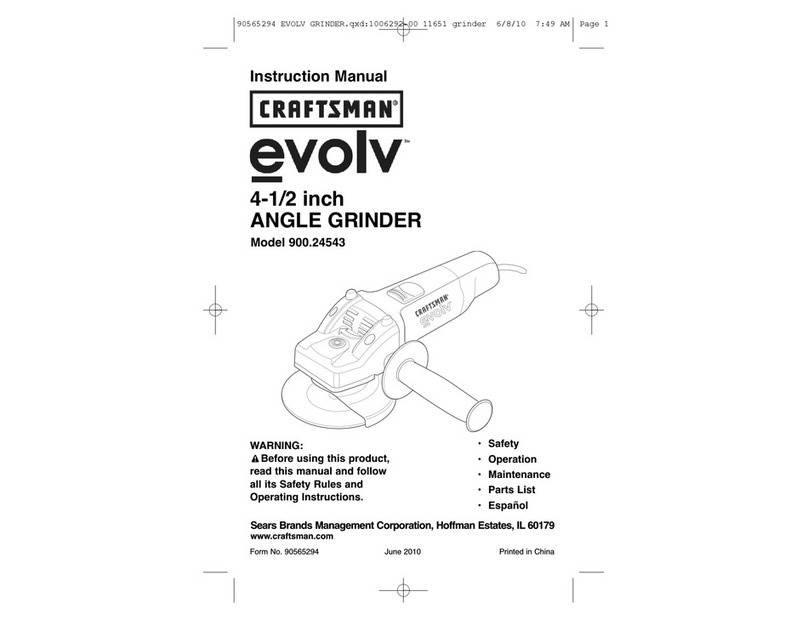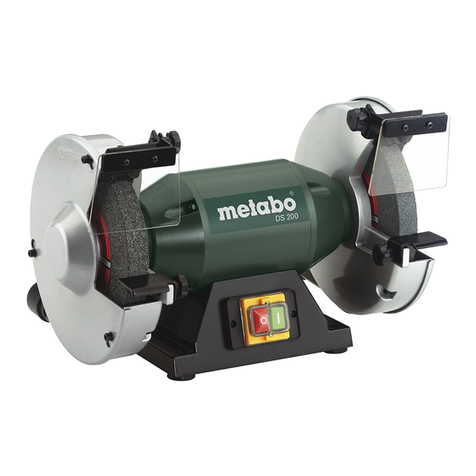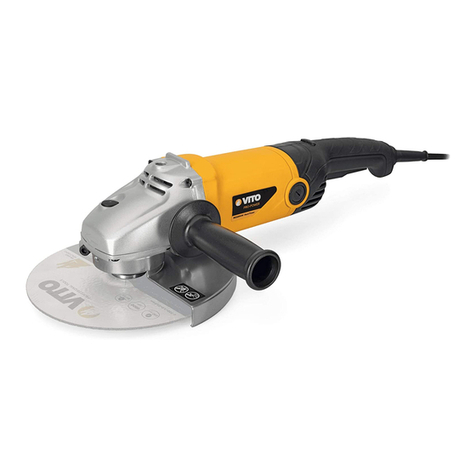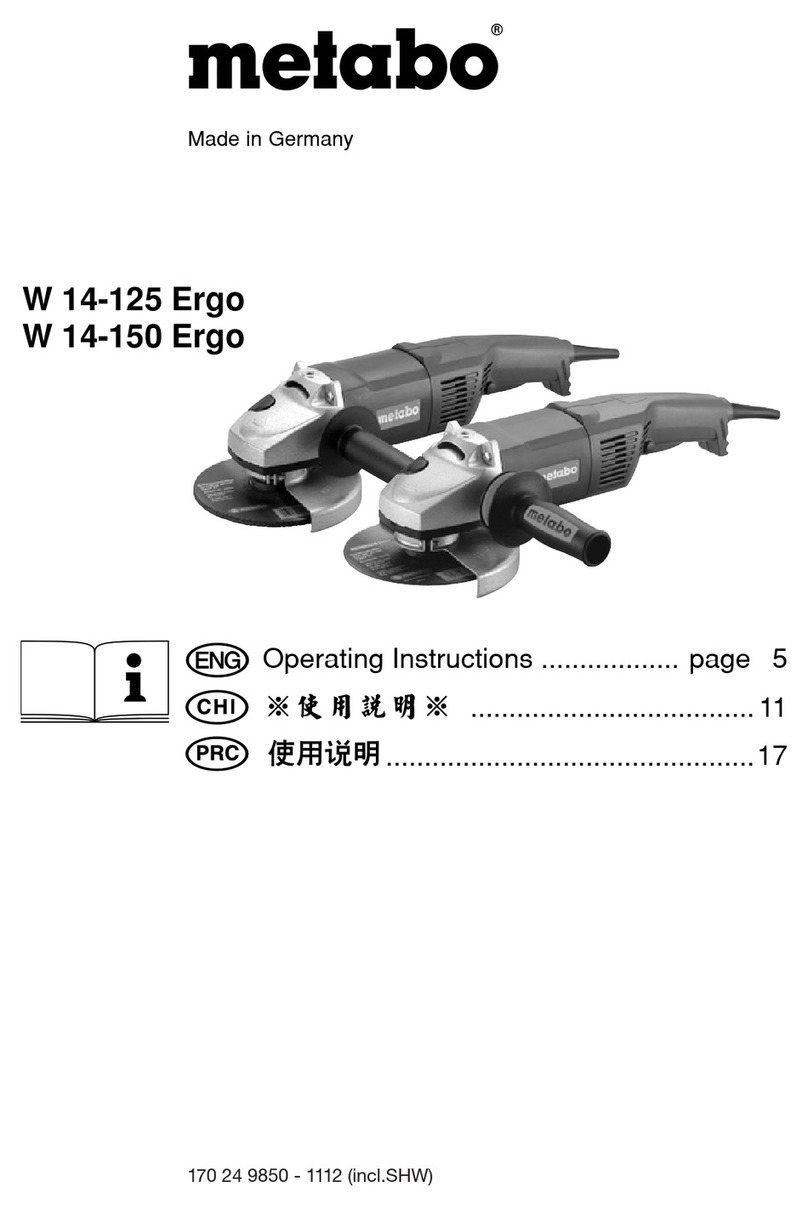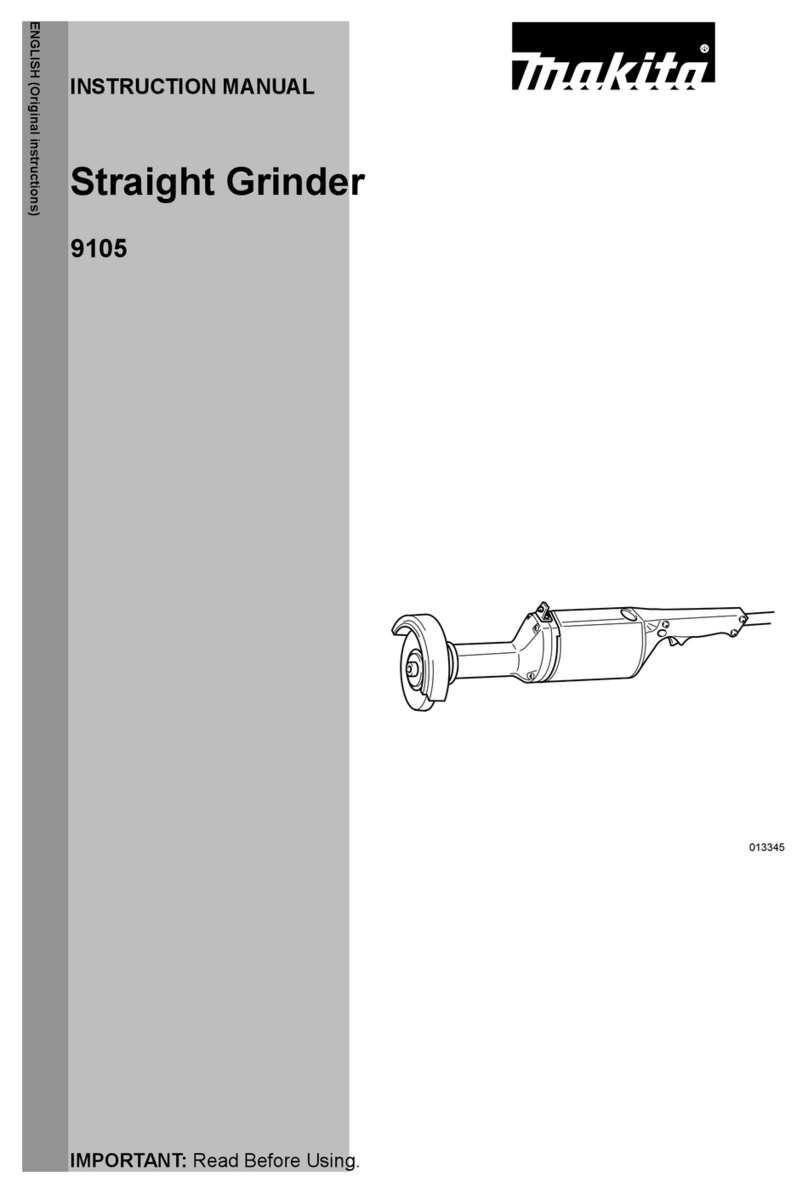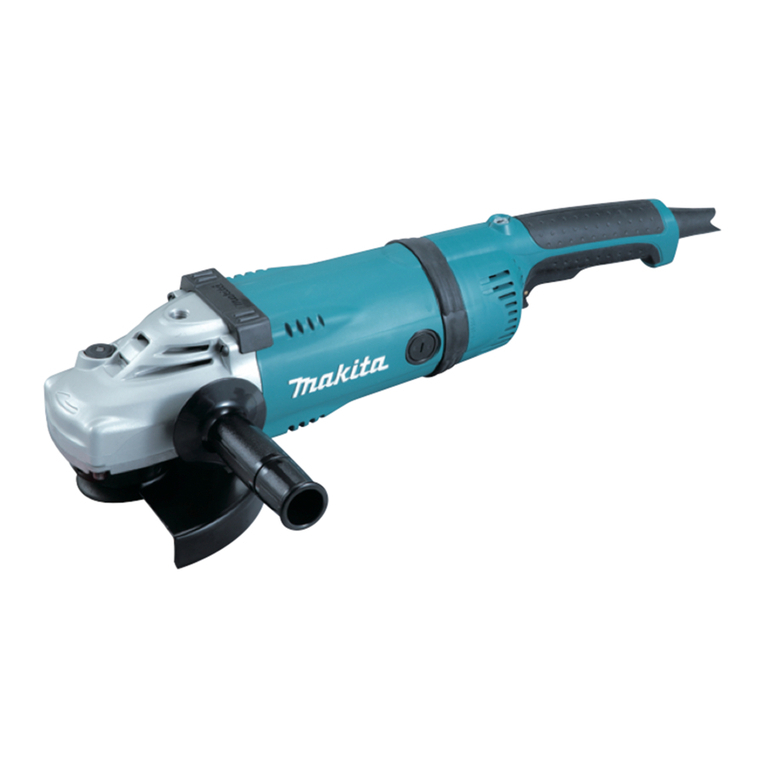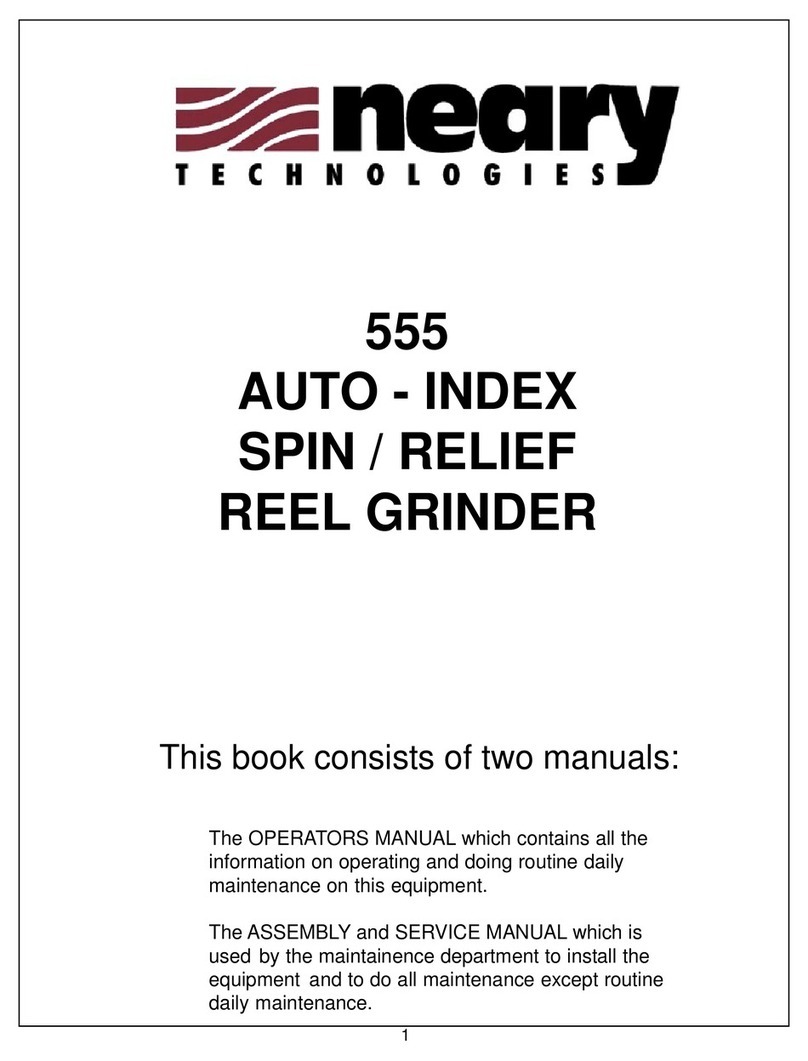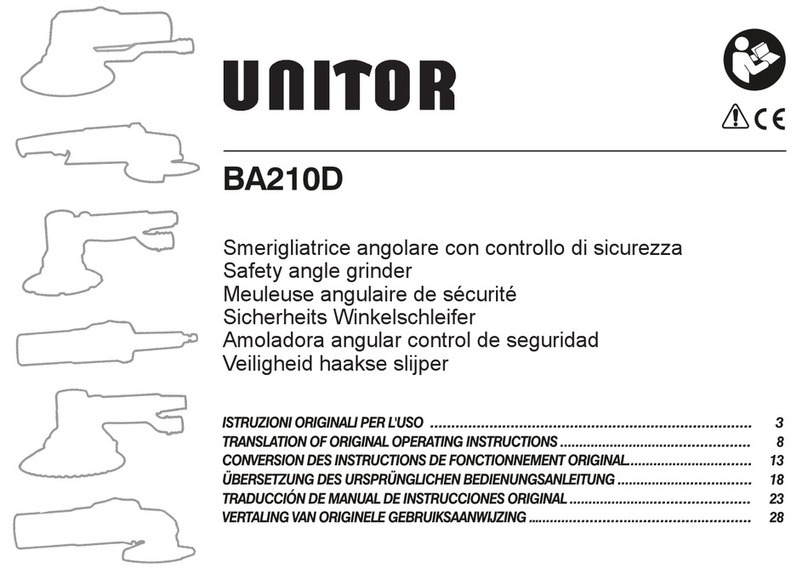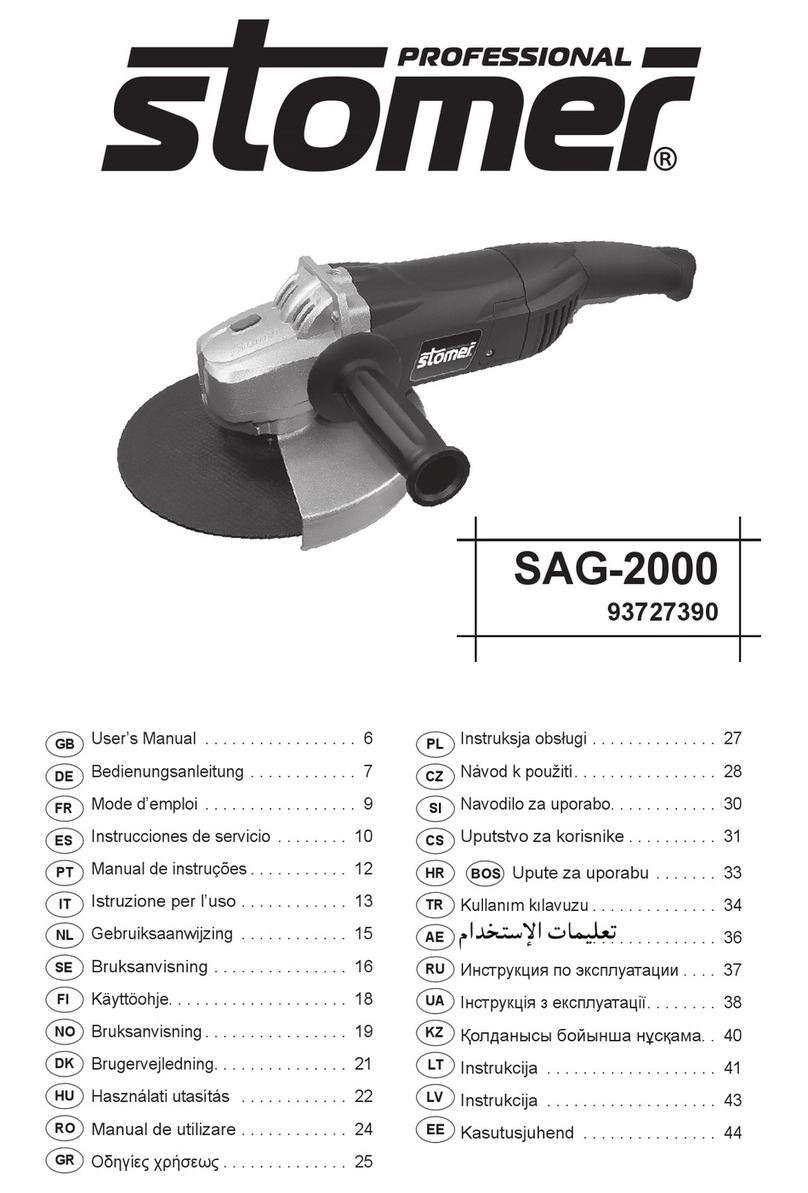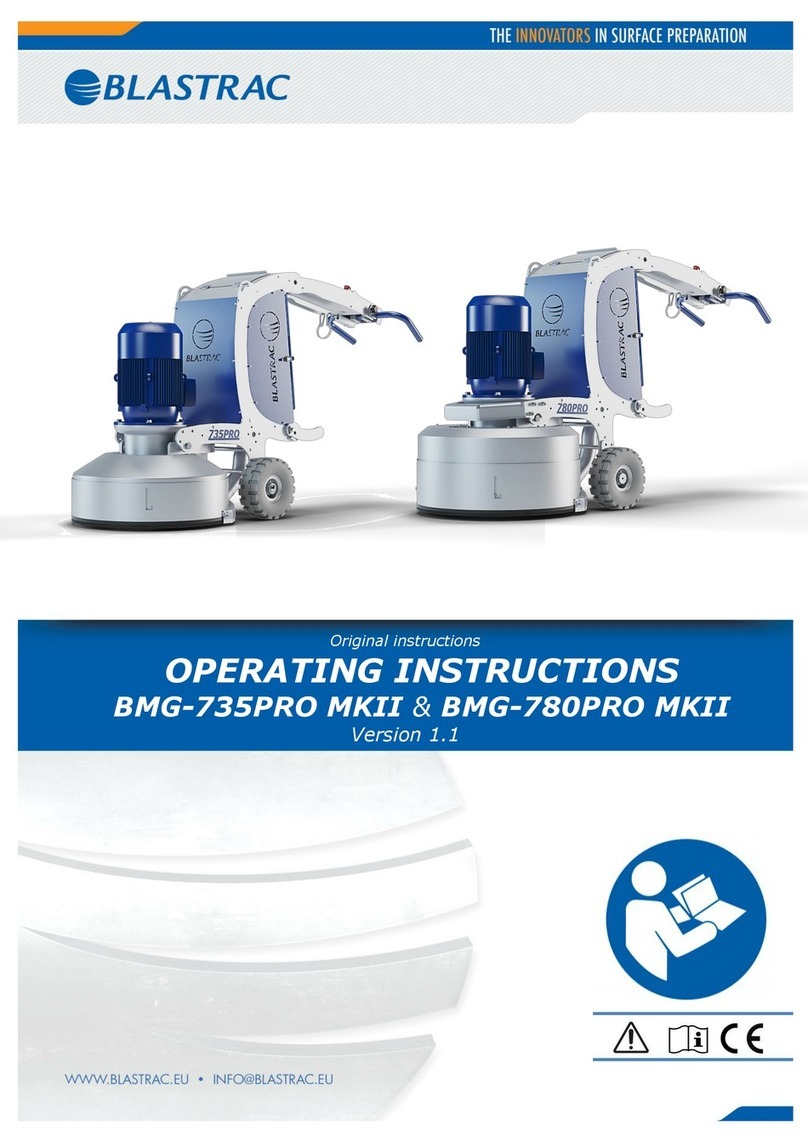Ingco AG8508 User manual

EN Angle Grinder
AG8508 UAG8508
AG8508E
AG8508S AG8508-1
AG8508-3 AG8508-4 AG8508-6 AG8508-8 AG8508-14
INGCO Global
INGCO Global

2|English
The symbols in instruction manual and the label on the tool
Double insulated for additional protection.
Read the instruction manual before using.
CE conformity.
Wear safety glasses, hearing protection and dust mask.
Wasteelectrical productsshouldnot be disposedof withhouseholdwaste.
Please recycle where facilities exist. Check with your Local Authority or
retailer for recycling advice.
Safety alert.
Please only use the accessories supported by the manufacturer.

3|English
WARNING Read all safety warnings and all instructions. Failure to
follow the warnings and instructions may result in electric shock, fire and/or
serious injury.
Save all warnings and instructions for future reference.
The term "power tool" in the warnings refers to your mains-operated (corded)
power tool or battery-operated (cordless) power tool.
1)
Work area safety
a)
Keep work area clean and well lit. Cluttered and dark areas invite
accidents.
b)
Do not operate power tools in explosive atmospheres, such as
in the presence of flammable liquids, gases or dust. Power tools
create sparks which may ignite the dust or fumes.
c)
Keep children and bystanders away while operating a power
tool. Distractions can cause you to lose control.
2)
Electrical safety
a)
Power tool plugs must match the outlet. Never modify the plug
in any way. Do not use any adapter plugs with earthed
(grounded) power tools. Unmodified plugs and matching outlets will
reduce risk of electric shock.
b)
Avoid body contact with earthed or grounded surfaces such as
pipes, radiators, ranges and refrigerators. There is an increased
risk of electric shock if your body is earthed orgrounded.
c)
Do not expose power tools to rain or wet conditions. Water
entering a power tool will increase the risk of electric shock.
d)
Do not abuse the cord. Never use the cord for carrying, pulling
or unplugging the power tool. Keep cord away from heat, oil,
sharp edges or moving parts. Damaged or entangled cords
increase the risk of electric shock.
e)
When operating a power tool outdoors, use an extension cord
suitable for outdoor use. Use of a cord suitable for outdoor use
reduces the risk of electric shock.
f)
If operating a power tools in a damp location is unavoidable, use
GENERAL POWER TOOL SAFETY WARNINGS

4|English
a residual current device (RCD) protected supply. Use of an RCD
reduces the risk of electric shock.
3)
Personal safety
a)
Stay alert, watch what you are doing and use common sense
when operating a power tool. Do not use a power tool while you
are tired or under the influence of drugs, alcohol or medication.
A moment of inattention while operating power tools may result in
serious personal injury.
b)
Use personal protective equipment. Always wear eye protection.
Protective equipment such as dust mask, non-skid safety shoes,
hard hat, or hearing protection used for appropriate conditions will
reduce personal injuries.
c)
Prevent unintentional starting. Ensure the switch is in the off-
position before connecting to power source and/or battery pack,
picking up or carrying the tool. Carrying power tools with your
finger on the switch or energizing power tools that have the switch on
invites accidents.
d)
Remove any adjusting key or wrench before turning the power
tool on. A wrench or a key left attached to a rotating part of the
power tool may result in personal injury.
e)
Do not overreach. Keep proper footing and balance at all times.
This enables better control of the power tool in unexpected
situations.
f)
Dress properly. Do not wear loose clothing or j ewellery. Keep
your hair, clothing and gloves away from mo ving parts. Loose
clothes, jewellery or long hair can be caught in moving parts.
g)
If devices are provided for the connection of dust extraction and
collection facilities, ensure th ese are connected and pr operly
used. Use of dust collection can reduce dust-relatedhazards.
4)
Power tool use and care
a)
Do not forc e the power tool. Us e the corr ect power tool for your
application. The correct power tool will do the job better and safer at
the rate for which it was designed.
b)
Do not use the power tool if the switch does not turn it on and off.
Any power tool that cannot be controlled with the switch is dangerous

5|English
and must be repaired.
c)
Disconnect the plug from the p ower source and/or the battery
pack from the po wer tool be fore making any adjustments,
changing accessories, or storing power tools. Such preventive
safety measures reduce the risk of starting the power tool accidentally.
d)
Store idle power tools out of the reach of children and do not allow
persons unfamiliar with the po wer tool or these instructions to
operate the po wer tool. Power tools are dangerous in the hands of
untrained users.
e)
Maintain power tools. Check for misalignment or bindin g of
moving parts, breakage of parts and an y other condition tha t may
affect the power tools operation. If da maged, have the power tool
repaired before use. Many accidents are caused by poorly maintained
power tools.
f)
Keep cutting tools sharp and clean. Properly maintained cutting tools
with sharp cutting edges are less likely to bind and are easier to control.
g)
Use the pow er tool, accessories and tool bits etc. in accor dance
with these instructions, taking into acc ount the working
conditions and the work to be performed. Use of the power tool for
operations different from those intended could result in a hazardous
situation.
5)
Service
a)
Have your power tool serviced by a qualified repair person using
only identical. This will ensure that the safety of the power tool is
maintained.

6|English
Additional SafetyWarnings
Safety instructions for all operations
Safety Warnings Common for Grinding, Sanding, Wire Brushing, Polishing or Abrasive Cutting-
Off Operations:
a)
This power tool is intended to function as a grinder, sander, wire brush, polisher or cut-off
tool. Read all safety warnings, instructions, illustrations and specifications provided with this
power tool. Failure to follow all instructions listed below may result in electric shock, fire and/or serious
injury.
b)
Operations such as grinding, sanding, wire brushing, polishing or cutting-off are not
recommended to be performed with this power tool. Operations for which the power tool was not
designed may create a hazard and cause personalinjury.
c)
Do not use accessories which are not specifically designed and recommended by the tool
manufacturer. Just because the accessory can be attached to your power tool, it does not assure safe
operation.
d)
The rated speed of the accessory must be at least equal to the maximum speed marked on the
power tool. Accessories running faster than their rated speed can break and fly apart.
e)
The outside diameter and the thickness of your accessory must be within the capacity rating of
your power tool. Incorrectly sized accessories cannot be adequately guarded or controlled.
f)
Threaded mounting of accessories must match the grinder spindle thread. For accessories mounted by
flanges, the arbour hole of the accessory must fit the locating diameter of the flange.
Accessories that do not
match the mounting hardware of the power tool will run out of balance, vibrate excessively and may cause loss of
control.
g)
Do not use a damaged accessory. Before each use inspect the accessory such as abrasive
wheels for chips and cracks, backing pad for cracks, tear or excess wear, wire brush for loose or
cracked wires. If power tool or accessory is dropped, inspect for damage or install an
undamaged accessory. After inspecting and installing an accessory, position yourself and
bystanders away from the plane of the rotating accessory and run the power tool at maximum no-
load speed for one minute. Damaged accessories will normally break apart during this test time.
h)
Wear personal protective equipment. Depending on application, use face shield, safety
goggles or safety glasses. As appropriate, wear dust mask, hearing protectors, gloves and
workshop apron capable of stopping small abrasive or workpiece fragments. The eye protection
must be capable of stopping flying debris generated by various operations. The dust mask or respirator
must be capable of filtrating particles generated by your operation. Prolonged exposure to high intensity
noise may cause hearing loss.
i)
Keep bystanders a safe distance away from work area. Anyone entering the work area must
wear personal protective equipment. Fragments of workpiece or of a broken accessory may fly away
and cause injury beyond immediate area of operation.
j)
Hold the power tool by insulated gripping surfaces only, when performing an operation where
the cutting accessory may contact hidden wiring or its own cord. Cutting accessory contacting a
"live" wire may make exposed metal parts of the power tool "live" and could give the operator an electric
shock.
k)
Position the cord clear of the spinning accessory. If you lose control, the cord may be cut or
snagged and your hand or arm may be pulled into the spinning accessory.
l)
Never lay the power tool down until the accessory has come to a complete stop. The spinning
accessory may grab the surface and pull the power tool out of your control.
m)
Do not run the power tool while carrying it at your side. Accidental contact with the spinning
accessory could snag your clothing, pulling the accessory into your body.
n)
Regularly clean the power tool’s air vents. The motor’s fan will draw the dust inside the housing

7|English
Further safety instructions for all operations
Additional safety instructions for grinding and cutting-off operations
and excessive accumulation of powdered metal may cause electrical hazards.
o)
Do not operate the power tool near flammable materials. Sparks could ignite these materials.
p)
Do not use accessories that require liquid coolants. Using water or other liquid coolants may
result in electrocution or shock.
Kickback and Related Warnings
Kickback is a sudden reaction to a pinched or snagged rotating wheel, backing pad, brush or any other
accessory. Pinching or snagging causes rapid stalling of the rotating accessory which in turn causes the
uncontrolled power tool to be forced in the direction opposite of the accessory’s rotation at the point of
the binding.
For example, if an abrasive wheel is snagged or pinched by the workpiece, the edge of the wheel that is
entering into the pinch point can dig into the surface of the material causing the wheel to climb out or kick
out. The wheel may either jump toward or away from the operator, depending on direction of the wheel’s
movement at the point of pinching. Abrasive wheels may also break under these conditions.
Kickback is the result of power tool misuse and/or incorrect operating procedures or conditions and can
be avoided by taking proper precautions as given below.
a)
Maintain a firm grip on the power tool and position your body and arm to allow you to resist
kickback forces. Always use auxiliary handle, if provided, for maximum control over kickback or
torque reaction during start-up. The operator can control torque reactions or kickback forces, if proper
precautions are taken.
b)
Never place your hand near the rotating accessory. Accessory may kickback over your hand.
c)
Do not position your body in the area where power tool will move if kickback occurs. Kickback
will propel the tool in direction opposite to the wheel’s movement at the point of snagging.
d)
Use special care when working corners, sharp edges etc. Avoid bouncing and snagging the
accessory. Corners, sharp edges or bouncing have a tendency to snag the rotating accessory and
cause loss of control or kickback.
e)
Do not attach a saw chain woodcarving blade or toothed saw blade. Such blades create frequent
kickback and loss of control.
Safety Warnings Specific for Grinding and Abrasive Cutting-Off Operations:
a)
Use only wheel types that are recommended for your power tool and the specific guard
designed for the selected wheel. Wheels for which the power tool was not designed cannot be
adequately guarded and are unsafe.
b)
The grinding surface of centre depressed wheels must be mounted below the plane of the
guard lip. An improperly mounted wheel that projects through the plane of the guard lip cannot be
adequately protected.
c)
The guard must be securely attached to the power tool and positioned for maximum safety, so
the least amount of wheel is exposed towards the operator. The guard helps to protect the operator
from broken wheel fragments, accidental contact with wheel and sparks that could ignite clothing.
d)
Wheels must be used only for recommended applications. For example: do not grind with the
side of cut-off wheel. Abrasive cut-off wheels are intended for peripheral grinding, side forces applied
to these wheels may cause them to shatter.

8|English
Additional safety instructions for cutting-off operations
Additional safety instructions for sanding operations
Additional safety instructions for polishing operations
Additional safety instructions for wire brushing operations
e)
Always use undamaged wheel flanges that are of correct size and shape for your selected
wheel. Proper wheel flanges support the wheel thus reducing the possibility of wheel breakage. Flanges
for cut-off wheels may be different from grinding wheelflanges.
f)
Do not use worn down wheels from larger power tools. Wheel intended for larger power tool is not
suitable for the higher speed of a smaller tool and mayburst.
Additional Safety Warnings Specific for Abrasive Cutting-Off Operations:
a)
Do not “jam” the cut-off wheel or apply excessive pressure. Do not attempt to make an
excessive depth of cut. Overstressing the wheel increases the loading and susceptibility to twisting or
binding of the wheel in the cut and the possibility of kickback or wheel breakage.
b)
Do not position your body in line with and behind the rotating wheel. When the wheel, at the
point of operation, is moving away from your body, the possible kickback may propel the spinning wheel
and the power tool directly at you.
c)
When wheel is binding or when interrupting a cut for any reason, switch off the power tool and
hold the power tool motionless until the wheel comes to a complete stop. Never attempt to
remove the cut-off wheel from the cut while the wheel is in motion otherwise kickback may occur.
Investigate and take corrective action to eliminate the cause of wheel binding.
d ) Do not restart the cutting operation in the workpiece. Let the wheel reach full speed and
carefully re-enter the cut. The wheel may bind, walk up or kickback if the power tool is restarted in the
workpiece.
e)
Support panels or any oversized workpiece to minimize the risk of wheel pinching and
kickback. Large workpieces tend to sag under their own weight. Supports must be placed under the
workpiece near the line of cut and near the edge of the workpiece on both sides of the wheel.
f)
Use extra caution when making a “pocket cut” into existing walls or other blind areas. The
protruding wheel may cut gas or water pipes, electrical wiring or objects that can cause kickback.
Safety Warnings Specific for Sanding Operations:
a) Do not use excessively oversized sanding disc paper. Follow manufacturers
recommendations, when selecting sanding paper. Larger sanding paper extending beyond the
sanding pad presents a laceration hazard and may cause snagging, tearing of the disc or kickback.
Safety Warnings Specific for Polishing Operations:
a) Do not allow any loose portion of the polishing bonnet or its attachment strings to spin freely.
Tuck away or trim any loose attachment strings. Loose and spinning attachment strings can entangle
your fingers or snag on the workpiece.
Safety Warnings Specific for Wire Brushing Operations:
a)
Be aware that wire bristles are thrown by the brush even during ordinary operation. Do not
overstress the wires by applying excessive load to the brush. The wire bristles can easily penetrate
light clothing and/or skin.
b)
If the use of a guard is recommended for wire brushing, do not allow any interference of the
wire wheel or brush with the guard. Wire wheel or brush may expand in diameter due to work load
and centrifugal forces.

9|English
Residual risks
Even when the po wer tool is used as prescribed it is not possible to
eliminate all residual risk factors. The follo wing hazards may arise in
connection with the power tool’s construction and design:
a)
Health defects resulting from vibration emission if the power tool is being
used over longer period of time or not adequately managed and properly
maintained.
b)
Injuries and damage to property to due to broken accessories that are
suddenly dashed.
Warning! This power tool produces an electromagnetic field during
operation. This field may under some circumstances interfere with active or
passive medical implants. To reduce the risk of serious or fatal injury, we
recommend persons with medical implants to consult their physician and the
medical implant manufacturer before operating this power tool.

10|English
1. SPINDLE LOCKING BUTTON
2. ON / OFF SWITCH BUTTON
3. HOUSING
4. POWER CABLE SLEEVE
5. COOLING VENTS
6. AUXILIARY HANDLE
7. DISC GUARD
8. DIRECTION OF ROTATION INDICATOR
9. THREAD LOCK FLANGE
10. MOUNTING WASHER FLANGE
10
9
7
6
2
8
5
1
4
3

11|English
TECHNICAL DATA
Model No.
AG8508 / AG8508E
AG8508-1
UAG8508
AG8508-3
(BS PLUG)
Voltage:
220-240V~50/60Hz
110-120V~60Hz
220-240V~50/60Hz
Input power:
950W
950W
950W
No-load speed:
11000/min
11000/min
11000/min
Disc diameter:
115mm
4-
115mm
Sanding plate diameter:
125mm
5
125mm
Wire cupbrush diameter:
75mm
3
75mm
Disc bore:
Ø22.2mm
Ø7/8
Ø22.2mm
Spindle thread:
M14
M14
Double insulation:
Weight: 2.75kg
2.75kg
2.75kg
AG8508-4 AG8508-14
(IRAM PLUG)
AG8508-8
(BS PLUG)
AG8508S
(SAA PLUG) AG8508-6
(ISRAEL PLUG)
Voltage: 220-240V~50/60Hz 220-240V~50/60Hz 220-240V~50/60Hz 220-240V~50/60Hz
Input power:
No-load speed:
Disc diameter:
Sanding plate diameter:
950W
11000/min
115mm
125mm
950W
11000/min
115mm
125mm
950W
11000/min
115mm
125mm
950W
11000/min
115mm
125mm
Wire cup brush diameter: 75mm
75mm
75mm 75mm
Disc bore:
Ø22.2mm
Ø22.2mm
Ø22.2mm
Ø22.2mm
Spindle thread:
M14 M14 M14 M14
Double insulation:
Weight:
2.75kg
2.75kg
2.75kg 2.75kg
ACCESSORIES
1. Auxiliary handle 1pcs
2. Spanner 1pcs
Model No.

12|English
OPERATION INSTRUCTIONS
WARNING: Before using your angle grinder be sure
to read the instruction manual carefully.
1. INSTALLING THE AUXILIARYHANDLE
(see fig 1)
An auxiliary handle is supplied and can be fixed into
both of the two positions on the gearcase. If you are
right handed fit the handle as shown in fig1. If you are
left handed fit the handle the other way round. When
using a cutting disc, you can screw the handle into the
position on top of the gearcase.
NOTE: This handle should be used at all times to
maintain complete control of the tool.
2. ADJUSTING WHEEL GUARD (see fig 2)
Adjust the guard to protect your hands and direct
grinding debris. Loosen the screw. Position the guard
at the required angle. Then tighten the screw.
CAUTION: Be sure that the guard is secure before
starting the angle grinder.
WARNING: Never use the angle grinder without the
disc guard in place.
3. FITTING THE DISCS (see fig 3)
Place the grinding/cutting disc on top of the inner flange
and over the spindle. Ensure that it is firmly located on
the raised section of the inner flange. See fig3. Locate
the outer flange over the disc, making sure that the
raised side is facting the disc and is fully located in the
centre hole of the disc.
NOTE: When clamping thin section metal diamond
discs, the outer flange must be reversed so that the
flat/dished side screws against the disc hub.
Press and hold down the spindle lock button and
tighten the outer flange using the two pin locking
wrench. It may be necessary to turn the spindle to
fully locate the spindle lock button.
When the outer flange washer is tight, release the
spindle lock button and remove the wrench.
Screw
Spindle

13|English
4.
SWITCH
(see fig 4)
The On/Off trigger switch is sprung in the OFF position.
The angle grinder is started by pushing forward the
on/off switch. See fig 4. To stop the angle grinder,
release the on/off switch and it will return to the OFF
position.
WARNING!
The disc will continue rotate for a few
seconds after the angle grinder has been switched off.
Fig 4
Fig 5
Always wait until the disc has stopped completely
before putting the angle grinder down. Do not attempt
to operate the spindle lock button while the disc is still
rotating.
5.
TO USE GRIND
(see fig 5)
Attention: Do not switch the grinder on whilst the disc
is in contact with the workpiece. Allow the disc to reach
full speed before starting to grind. Hold your angle
grinder with one hand on the main handle and other
hand firmly around the auxiliary handle.
Always position the guard so that as much of the
exposed disc as possible is pointing away from you.
Be prepared for a stream of sparks when the disc
touches the metal.
For best tool control, material removal and minimum
overloading, maintain an angle between the disc and
work surface of approximately 15°-30° when grinding
and 10°-15° When sanding. Exert light pressure on
abrasive discs for efficient operation. Pushing too
hard will cause a drop in speed and may result in
motor overload and damage.
Use caution when working into corners as contact
with the intersecting surface may cause the grinder
to jumo or twist, When grinding is complete allow the
workpiece to cool. Do not touch the hot surface.
6. OVERLOAD
Overloading will cause damage to the motor of your
angle ginder. This can happen if your angle grinder
is subjected to heavy use for prolonged periods of
time. Do not in any circumstances, attempt to exert
too much pressure on your angle grinder to speed
up your work.
On/off
switch button

14|English
The abrasive discs operate more efficiently when light pressure is exerted, thus avoiding a drop in
the speed of your angle grinder. If your angle grinder becomes too hot, run your angle grinder under
no load for 2-3 minutes until it has cooled to normal operation temperature.
WORKING HINTS FOR YOUR ANGLE GRINDER
1. Your angle grinder is useful for both cutting through metals, ie.for removing screw heads, and also
for cleaning / preparing surfaces, ie.before and after welding operations.
2. Different types of wheel/cutter will allow the grinder to meet various needs. Typically, grinding
wheels/cutting discs are available for mild steel, stainless steel, stone and brick. Diamond
impregnated discs are available for very hard materials.
3. If the grinder is used on soft metals such as aluminum the wheel will soon clog and will have to be
changed.
4. At all times, let the grinder do the work, do not force it or apply excessive pressure to the
wheel/disc.
5. If cutting a slot ensure that the cutter is kept aligned with the slot, twisting the cutter may cause the
disc to shatter. If cutting through thin sheet, only allow the cutter to just project through the material,
excessive penetration can increase the chance of causing damage.
6. If cutting stone or brick, it is advisable to use a dust extractor.
MAINTENACE
WARNING:
Ensure the grinder is disconnected from the mains power supply beofre
attempting any maintenance.
1. Keep the grinder ventilation slots clean and free from ocstructions. If available, blow compressed
air into the vents to clear any internal dust (safety goggles must be worn whrn undertaking this
process).
2. Keep the outer case of the grinder clean and free from grease, Do not wash with water or use
solvents or abrasive. Use only mild soap and a damp cloth to clean the tool. Never let any liquid get
inside the tool. Never immerse any part of the too into a liquid.
3. Your angle grinder requires no additional lubrication. There are no user serviceable parts in your
powe tool.
4. Always store your power tool in a dry place.
5. If you see some sparks flashing in the ventilation slots, this normal and will not damage your power
tool.
TROUBLESHOOTING
Although your new angle grinder is really very simple to operate, if you do experience problems,
please check the following:
1. If you grinder will not operate, check the power at the mains plug.
2. If your grinder wheel wobbles or vibrates, check that outer flange is tight, check that the wheel is
correctly located on the flange plate.
3. If there is any evidence that the wheel is damaged, do not ues as the damaged wheel may
disintegrate, remove it and replace with a new wheel. Dispose of old wheels sensibly.
4. If working on aluminum or a similar soft alloy, the wheel will soon become clogged and will not
grind effectively.
ENVIRONMENTAL PROTECTION
Waste electrical products should not be disposed of with household waste. Please recycle
where facilities exist. Check with your Local Authority or retailer for recycling advice.

15|English
AG8508,UAG8508,AG8508E,AG8508S,AG8508-1,AG8508-3,AG8508-4,
AG8508-6,AG8508-8,AG8508-14

16|English
AG8508,UAG8508,AG8508E,AG8508S,AG8508-1,AG8508-3,AG8508-4,
AG8508-6,AG8508-8,AG8508-14
No.
Part Description
Qty
No.
Part Description
Qty
1
outer flange
1
26
middle plate
1
2
inner flange
1
27
armature
1
3
wheel guard
1
28
dust-proof ring
1
4
spindle
1
29
dust-proof spacer
1
5
dust cover
1
30
bearing 626
1
6
screw M4x12
4
31
bearing sleeve
1
7
gear box cover
1
32
screw ST4x75
2
8
wool ring
1
33
fan guard
1
9
ring
1
34
stator
1
10
bearing 6001
1
35
housing
1
11
bearing room cover
1
36
carbon brush
2
12
screw M5x10
3
37
brush box
2
13
big gear
1
38
screw ST3x8
2
14
needle bearing
1
39
screw ST4x12
2
15
gear box
1
40
switch
1
16
screw ST5x25
4
41
push button
1
17
pin
1
42
pushrod
1
18
spring
1
43
rear cover
1
19
cap
1
44
wrench
1
20
auxiliary hanlde
1
45
screw ST4x14
2
21
nut
1
46
cable clamp
1
22
pinion
1
47
screw ST4x18
1
23
circlip for hole
1
48
cable sleeve
1
24
bearing 608
1
49
cable
1
25
ring
1
This manual suits for next models
9
Table of contents
Other Ingco Grinder manuals

